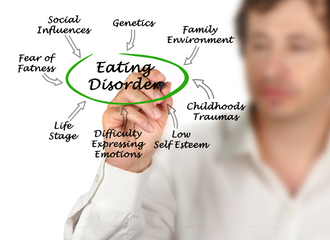Written by: Ashley Moser, LMFT, CEDS
Regional Assistant Vice President, The Renfrew Center
Eating disorder symptoms can be difficult to identify – especially when a family member, friend, partner, or loved one is involved. In this post, we review 5 warning signs to look out for and 5 suggestions for starting the conversation.

- When is healthy ‘too healthy’?
- When is exercise excessive?
- Is this a temporary diet or an eating disorder?
The development of an eating disorder involves a perfect storm of many factors; there is never a single cause. But like many illnesses, disorders such as anorexia nervosa, bulimia nervosa and binge eating disorder can be life-threatening when left undetected and untreated.
So, in a culture obsessed with thinness and dieting, how can an eating disorder be identified? While not all individuals who have an eating disorder exhibit the same exact symptoms, the first step is learning to recognize the warning signs.
Top 5 Warning Signs of an Eating Disorder

- Obsession around food, weight and shape.
- Distorted or negative self-image.
- Withdrawal from normal social activities, including meals with others.
- Unusual eating behaviors including cutting food into small pieces, eating slowly, eating unusual food combinations, feeling out of control over ability to stop eating.
- Changes in mood including irritability, mood swings, depression, anxiety, or restlessness.
How to Help a Loved One Who Is Exhibiting Symptoms
Approaching someone who exhibits symptoms of an eating disorder is a delicate task. Fear that a loved one or friend will get mad, withdraw from the relationship or cause the person’s eating disorder to worsen, may keep some individuals from taking a risk to speak up about their concerns.
Though these fears exist, it is important to understand that eating disorders are not fads, phases or eccentricities that will resolve on their own. Eating disorders are one of the deadliest psychiatric disorders and involve dangerous ways of thinking and behaving.
These conversations, although often extremely difficult, are crucial in order to address the emotional and physical toll exacted by the eating disorder and bring the issue out into the open.
5 Ways to Broach the Conversation Around an Eating Disorder
- Set The Stage
Talk to your loved one in a calm state and free from distraction or interruption. Being empathic and caring is just as important as the content of the conversation itself. - Share What You Have Noticed
Mention specific observations or instances that suggest disordered eating. Do not focus on appearance or weight; instead, talk about mood and relationships.
- Talk About Change
Help identify the positive reasons to change and the consequences of staying the same. Change is difficult; focusing on what the individual values may be helpful in building motivation. - Offer Help
While a strong support system is extremely valuable, professional help is needed to address the eating disorder. Encourage your loved one to speak with a professional. Offer to help them look for qualified providers, and/or offer to accompany them to a therapy session or tour a treatment facility. - Be Patient Yet Persistent
Do not give up. Eating disorders do not develop overnight and breaking through denial can take time. Continue to suggest professional help and point out the benefits of change. This process might take more than one conversation. Consider seeking out the guidance of an outside expert for an assessment or intervention.
Conclusion

If someone you love is struggling with an eating disorder, it is important that they seek professional help through their primary care physician, a psychotherapist, or a treatment facility, such as The Renfrew Center.





